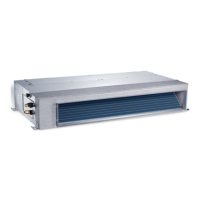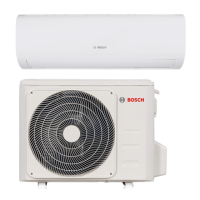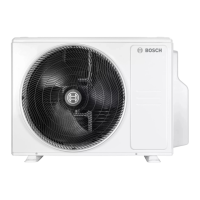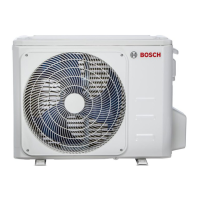22
|
Service Manual
Bosch Climate 5000 Series Ductless Air Conditioner / Heat Pump Multi Zone Outdoor Units (01.2023)
6.4 First Time Installation
6.4.1 Air Purging with Vacuum Pump
Figure 16
(Indoor Unit)
(Liquid Side)
(Gas Side)
(Outdoor Unit)
Liquid Service Line
Gas Service Line
Manifold Valve
Compound Meter
Pressure
Gauge
Handle Lo
Handle Hi
-0.1MPa
Shut-Off Knob
Low Refrigerant
Manifold/Blue
Shut-Off Knob High
Charge/Refrigerant Hose
Vacuum
Pump
1. Completely tighten the flare nuts of the indoor and outdoor units, confirm
that both the liquid service and gas service valves are set to the closed
position.
2. Connect the refrigerant manifold; blue hose with the shut-off knob of the low
side to the gas service valve port.
3. Connect the refrigerant manifold; yellow hose to the shut-off high side
connection to the vacuum pump.
4. Fully open the shut-off knob low side of the manifold valve.
5. Operate the vacuum pump to evacuate.
6. Perform evacuation for 30 minutes and check whether the refrigeration
low side pressure gauge indicates 350 ~500 microns. If the meter does
not indicate 350 ~ 500 microns after evacuating for 30 minutes, it should
be evacuated 20 minutes more. If the pressure can’t hold 350 ~ 500
microns after evacuating 50 minutes, please check if there are any leakage
points. Fully close the shut-off knob low side of the manifold and stop the
operation of the vacuum pump. Confirm that the gauge needle does not move
(approximately 5 minutes after turning off the vacuum pump).
7. Make sure the pressure display in the pressure indicator is a little higher than
the atmospheric pressure. Then remove the charge hose from the gas service
valve.
8. Fully open the liquid service valve and gas service valve and securely tighten
the cap of the gas service valve. System is now evacuated and charged.
(Ensure that the unit is charged per the defined specifications).
Gas leak check:
— Required after completion of refrigerant line set installation
— Unit service valves remain closed to isolate refrigerant into
outdoor unit (condensing section)
— Line set and coil should be pressurized to at least 150 PSIG
using dry Nitrogen
— Check for leaks using bubble solution at each braze joint
6.5 Adding the Refrigerant to an Existing System
Figure 17
(Indoor Unit)
(Liquid Side)
(Gas Side)
(Outdoor Unit)
Liquid Service Line
Gas Service Line
Check Valve
Refrigerant
Cylinder
Electronic Scale
OPEN CLOSE
Procedure
1. Connect the refrigerant manifold, blue suction hose to the gas service valve's
service port, open the liquid service valve and the gas service valve. Connect
the refrigerant manifold, yellow hose to the valve at the top or bottom of the
cylinder. If the refrigerant is R410A, ensure that cylinder is placed upside
down during the charging process.
2. Purge the air from the refrigerant manifold (yellow hose). Open the valve at
the top or bottom of the cylinder and press the check valve on the refrigerant
manifold to purge the air.
CAUTION: CONTAINS REFRIGERANT
f Liquid refrigerant can cause frost bite. Handle with care.
3. Place the refrigerant cylinder onto the electronic scale and record the weight.
4. Operate the air conditioner in cooling mode.
5. Open the valve (low side) on the refrigerant manifold and charge the system
with liquid refrigerant.
6. When the electronic scale displays the proper weight (refer to the gauge and
the pressure of the low side), turn off the refrigerant low side valve and the
refrigerant cylinder valve. Then turn off the unit to remove the hose from the
gas service valve.
7. Replace valve stem caps on the service port. Use a torque wrench to tighten
the service port cap to a torque of 18N.m. Be sure to check for gas leakage.
Recover the refrigerant as per Refrigerant Recovery and Recycling
Equipment manufacturers' specification.

